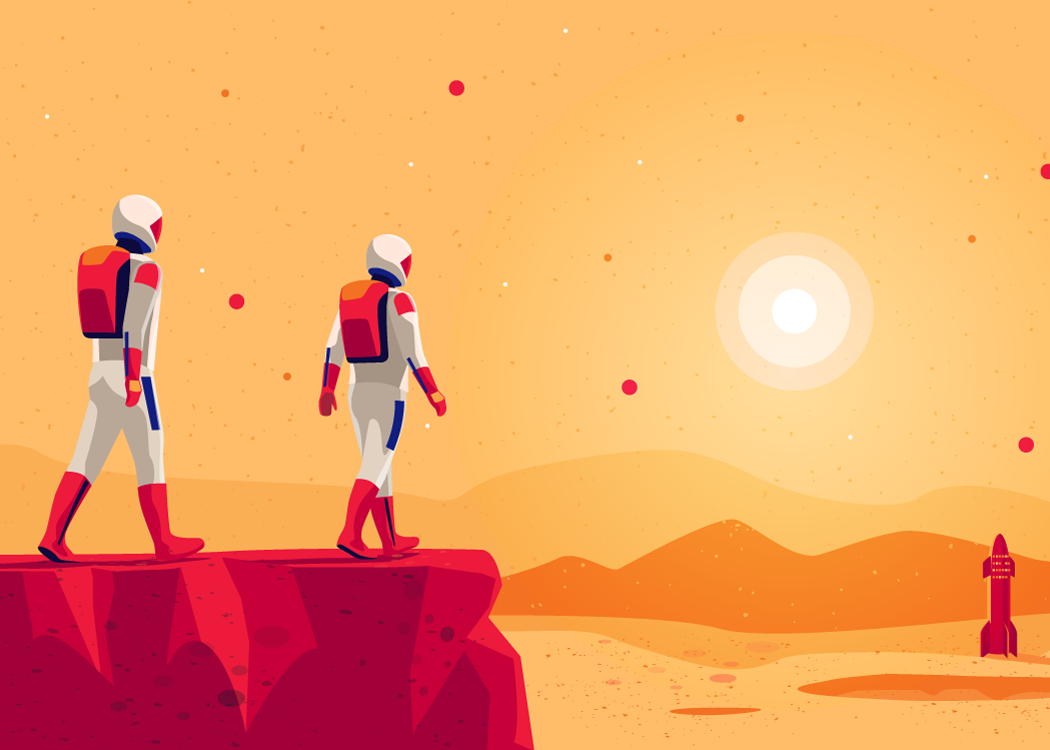
|
 |
Artist illustration of astronauts on Mars (Credit: petovarga/Adobe Stock) |
|
Two University of Maryland (UMD) teams were among the twelve teams selected by NASA and the National Space Grant Foundation to support space habitats and deep space exploration missions. The selections are part of the Moon to Mars eXploration Systems and Habitation (M2M X-Hab) Academic Innovation Challenge sponsored by NASA’s Mars Campaign Office.
Mentored by Department of Aerospace Engineering Professor David Akin, who is also the director of Maryland’s Space Systems Laboratory, the UMD teams will develop two different projects aimed at improving systems for space habitats and deep space exploration missions:
One team will focus on the “Design and Development of a Lightweight Spacesuit Portable Life Support System” project to develop, model, and test innovative concepts for portable life support system con?gurations to support extravehicular activities on the Moon, Mars, and in microgravity.
Based on current plans, the spacesuits and backpack-mounted portable life support systems for the Artemis moon mission program will be twice as massive as those used for the Apollo mission.
While this added mass will increase capabilities and decrease risk, astronauts may well be wearing a life support system for spacewalks that weighs twice or even three times their body weight.
“This is feasible on the Moon, where gravity is only one sixth that of Earth,” explains Akin. “But when we go to Mars, the gravitation is two and a half times that of the Moon, and ongoing research in the Space Systems Laboratory (supported by NASA Johnson Space Center) is showing that the lunar spacesuits may well be too heavy for astronauts to use on Mars.”
As a separate project, an aerospace engineering capstone course design team (ENAE 483/484) will take a “blank sheet” look at extravehicular life support, and try to innovate systems to reduce the weight demands on Martian astronauts.
Team two is developing “Actuated Inflatable Tunnels for Pressurized Transfer.” This project is an innovative concept for shirtsleeve crew mobility between planetary surface habitats under lunar and Mars gravity conditions.
As the International Space Station was expanded in the microgravity of low Earth orbit, new modules could be floated into perfect alignment with the existing structure for connection.
However, as Akin explains, in the gravitational environment of the lunar surface, such perfect alignments will be impossible. Connecting two modules to expand a lunar habitat would involve a separation in physical distance, as well as probable misalignments in position or orientation.
“For decades people have assumed some sort of flexible connector will be used to establish a shirtsleeve passageway between habitat modules,” said Akin. “But little work has been done to design these tunnels.”
He adds that one of the greatest challenges to this idea is that it is not only inefficient, but potentially hazardous to ask astronauts to manually make these connections in spacesuits, especially considering the weight of the tunnel elements.
The project, which will also be pursued by an ENAE 483/484 capstone design team, will involve not just the design of the pressurized connecting envelope but also a mechanism to allow the tunnel to remotely control its end-point, and to enable an autonomous connection between two adjacent habitats even without humans present on the Moon.
NASA’s M2M X-Hab Academic Innovation Challenge is an opportunity to build strategic partnerships with universities and tap into the ingenuity of the future workforce.
The challenge provides STEM (Science, Technology, Engineering and Mathematics) students interested in aerospace careers with hands-on development and research experience, while strengthening NASA capability for missions to the Moon, Mars, and beyond.
Related Articles:
Two UMD Teams Take Best in Theme at NASA’s RASC-AL Competition
Nguyen Lands DARPA Young Faculty Award
Soliton Signatures: A New Strategy for Tracking Teeny Tiny Space Debris
Hartzell Mission Scientist for NASA SIMPLEx Janus Mission
Unraveling the Mysteries of Asteroids
Alumna Epps Selected as Astronaut
UMD Team Advances Mission Concept for 2029 Asteroid Flyby
Akin Receives 2025 ICES Award for Technical Excellence
Aerospace Engineering at Maryland Expanding Online Graduate Courses This Fall
Department Welcomes New Faculty Member Tam Nguyen
August 12, 2025
|

